Cut your vegetables into uniform 1/2-inch to 1-inch pieces using a sharp chef's knife and stable cutting board. You'll want to slice root vegetables like carrots and potatoes into consistent cubes, while cutting leafy greens into thin ribbons. Make diagonal cuts at 45-degree angles to maximize surface area for better heat absorption and even cooking. Pat vegetables dry after washing and toss them in olive oil and seasonings, ensuring each piece is well-coated. For ideal sun-baked results, arrange pieces in a single layer without overlapping. The right cutting technique can reduce your cooking time by up to 30% and enhance flavor absorption.
Essential Cutting Tools and Equipment
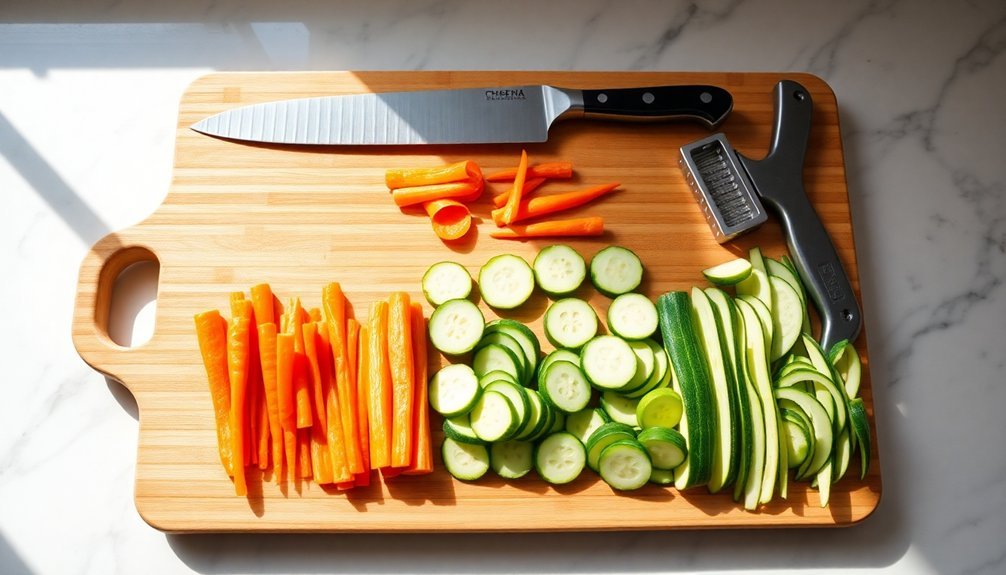
Three essential tools form the foundation of proper vegetable cutting: a sharp chef's knife, a reliable cutting board, and a paring knife for detailed work.
You'll use your chef's knife for most tasks, from chopping carrots to dicing potatoes, while the paring knife handles smaller, more delicate items like mushrooms and cherry tomatoes. When cutting vegetables for solar cooking, aim for uniform pieces that will cook evenly in direct sunlight.
Your cutting board provides a stable, hygienic surface that protects both your countertops and your knife blades.
To complement these basics, you'll want a peeler for removing vegetable skins and a colander for washing and draining. A ruler helps guarantee uniform cuts for even cooking, while protective gloves offer extra safety.
Remember to keep your knives sharp and always cut away from your body, curling your fingers under to prevent accidents.
Perfect Sizes for Solar Cooking
Solar cooking demands specific vegetable sizes to achieve perfect results. You'll want to cut most vegetables into uniform pieces to guarantee even cooking throughout.
For root vegetables, aim for 1/2-inch cubes or slices, while carrots should be cut into 1/4 to 1/2-inch pieces for best results. Using a SunGlobe solar barbecue will ensure optimal heat distribution for these sizes.
When preparing cauliflower, break it into medium-sized florets that'll retain their texture during the longer cooking process. Slice zucchinis into 1/4-inch rounds or strips using a julienne cut.
For leafy herbs like parsley, you can either finely chop them or leave whole leaves for garnishing your final dish.
Remember that larger pieces will maintain more crunchiness, while smaller cuts will cook faster. Match your cutting size to your desired texture and cooking time.
Chopping Root Vegetables
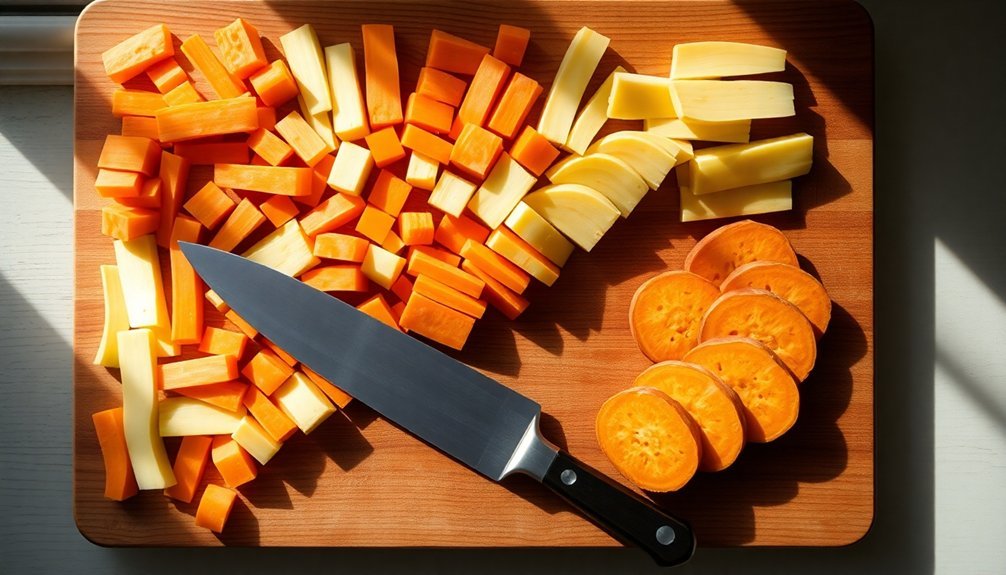
Proper chopping technique makes all the difference when working with root vegetables. You'll need a sharp kitchen knife and a stable cutting surface to guarantee safe, precise cuts.
Start by washing your vegetables thoroughly and removing any unwanted parts like tops or roots. Maintain proper grip by pinching the blade between your thumb and forefinger while wrapping remaining fingers under the handle.
When cutting carrots, you can either peel them or scrub them well with a Brillo pad. For uniform cooking, cut your vegetables into consistent sizes.
If you're making carrot rounds, use the heel of your knife while keeping the tip on the cutting board. For diced carrots, quarter them lengthwise first, then cross-cut.
Keep the flat side down for stability as you work. Use a swooping motion with your knife for better control, and stack trimmed pieces together when cross-cutting to save time.
Leafy Greens Preparation Methods
Getting leafy greens ready for cooking involves essential steps that preserve their freshness and enhance their flavor. Start by removing tough stalks from the center of leaves, but keep the thinner ones. You'll want to discard any wilted or brown leaves, then rinse everything thoroughly under cold water.
To cut leafy greens effectively, stack 3-4 leaves on top of each other and roll them tightly. Using the chiffonade technique, slice across the rolls to create fine ribbons.
For blanching, drop the leaves into boiling water briefly, then transfer them to an ice bath to maintain their vibrant color and crispness. Once they're drained, you can reheat them quickly by sautéing with seasonings or adding them directly to your favorite dishes.
Seasoning Large Cut Pieces
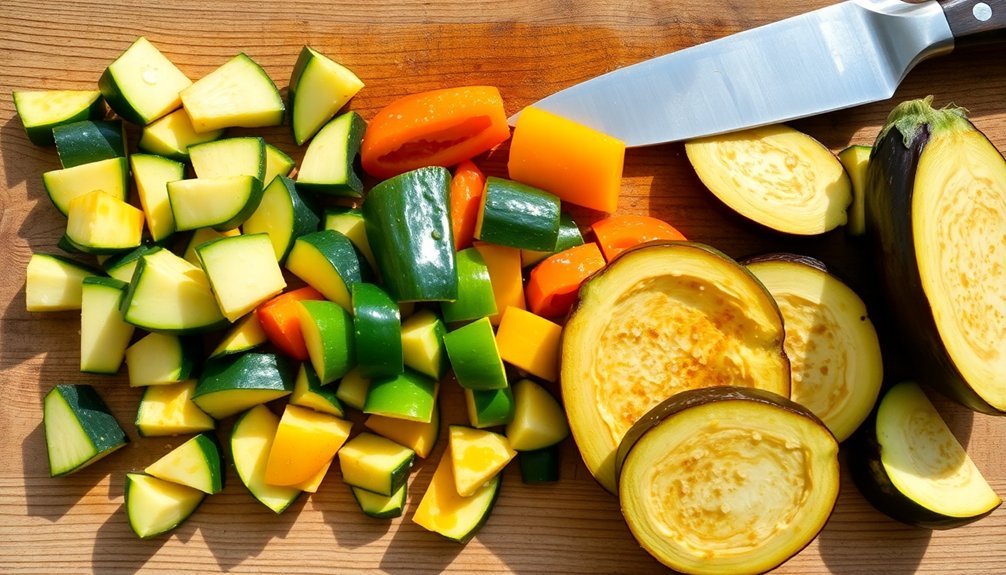
To season large vegetable chunks effectively, you'll need to start with a thorough herb coating that includes your choice of dried or fresh herbs mixed with oil.
Your vegetables will absorb flavors better when you first toss them in olive oil and salt, allowing the seasoning to penetrate deeply into the cuts.
You can enhance the coating process by using your hands to massage the oil-herb mixture into the vegetable pieces, ensuring every surface gets even coverage.
Herb Coating For Chunks
A flavorful herb coating transforms ordinary vegetable chunks into savory, aromatic delights. Start by combining olive oil, balsamic vinegar, and your choice of fresh herbs like basil, parsley, and rosemary.
You'll want to add minced garlic or garlic powder for depth.
Before applying your herb mixture, make certain you've cut your vegetables into uniform pieces. For grilling, cut zucchini and eggplant into 1/4-inch slices, quarter your bell peppers, and trim whole asparagus stems.
When roasting, toss your chunks in a bowl with an avocado oil-herb blend until they're thoroughly coated. Remember to spread them in a single layer on your baking sheet.
For maximum flavor, you can add more herb mixture halfway through cooking. This technique works well for both grilled and roasted vegetables.
Oil-Salt Penetration Methods
Proper oil and salt penetration transforms large vegetable pieces into deeply seasoned, flavorful dishes. Start by drizzling olive oil over your cut vegetables, ensuring they're lightly coated but not swimming in oil. This coating helps conduct heat and prevents moisture loss during cooking.
For ideal salt penetration, you'll want to create a brine solution using 5-8% salt concentration for dense vegetables like sweet potatoes. Let them soak for up to four hours.
Before brining, it's essential to peel and cut your vegetables into uniform sizes, which allows the salt to diffuse effectively across cell membranes.
Don't forget to dry your vegetables thoroughly after washing to prevent steaming. Monitor the brining time carefully to achieve the perfect balance of seasoning without over-salting your dishes.
Solar Friendly Vegetable Combinations
Understanding how vegetables interact with sunlight can make or break your garden's success. When planning your garden layout, pair sun-loving vegetables like cucumbers and squash together in areas that receive 6-8 hours of direct sunlight.
You'll get better results by combining eggplants with beans and peppers in these sunny spots.
For partial shade areas, group peas, broccoli, and cabbage together, as they'll thrive with 4-6 hours of sunlight.
However, don't plant tomatoes near corn, as they attract similar pests. Also, keep potatoes away from cucumbers and tomatoes to prevent pest problems.
When companion planting, try proven combinations like cucumbers with dill and nasturtiums, or squash with marigolds. These pairings will help maximize your garden's productivity while naturally deterring unwanted insects.
Uniform Cutting Techniques
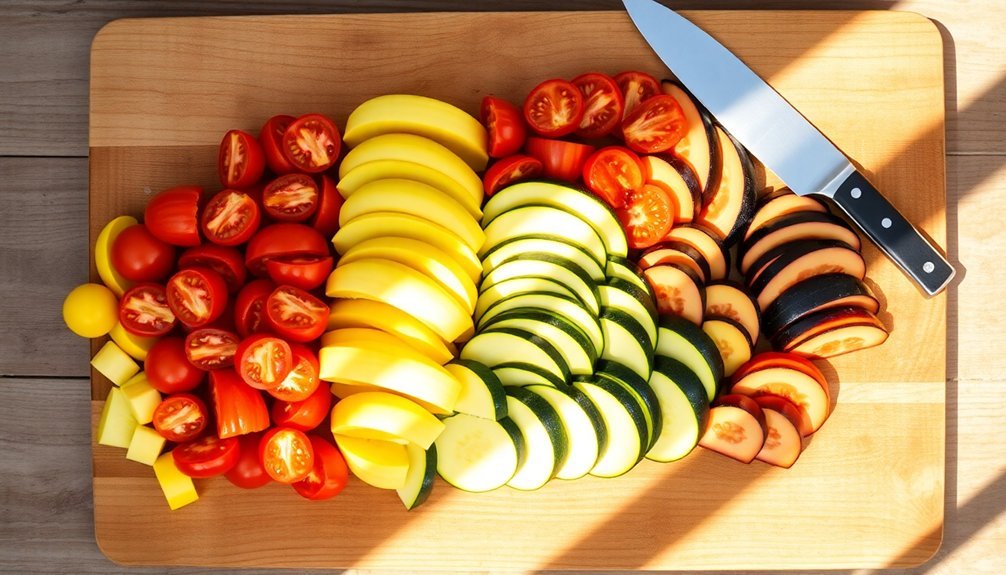
Mastering uniform cutting techniques is essential for professional-looking dishes and even cooking times. You'll want to focus on four main cuts: brunoise (1/8-inch cubes), dice (small uniform cubes), julienne (matchstick strips), and mince (very fine paste-like pieces).
For ideal sun-baked results, remember these key cutting principles:
- Start with a stable base by creating a flat surface on your vegetable before proceeding with any cut.
- Stack similar-sized pieces when cutting multiple items to maintain consistency.
- Use a rocking motion with your knife for mincing, gathering the pieces frequently to guarantee uniform size.
Each technique serves a specific purpose – brunoise for root vegetables, julienne for quick-cooking items, dice for hearty ingredients, and mince for aromatics that need to distribute flavor evenly throughout your dish.
Maximizing Surface Area Coverage
When you're cutting vegetables, diagonal cuts give you more surface area to work with, which means better heat distribution and faster cooking times.
You'll want to cut at angles between 30-60 degrees to maximize the exposed surfaces that come in contact with your pan or grill.
Just as plants turn their leaves to catch more sunlight, your angled cuts create more flat surfaces that can absorb heat and seasonings efficiently.
Diagonal Cuts Matter
Making diagonal cuts is an essential technique that transforms how your vegetables cook and taste. When you slice at a 45° to 60° angle, you'll expose more surface area, allowing your vegetables to cook faster and absorb more flavors from sauces and seasonings.
For perfect diagonal cuts, remember these key steps:
- Position your vegetable on the cutting board and hold your knife at a 45° angle.
- Make uniform slices about 1/4 inch thick and 2-3 inches long.
- Keep your elbow tucked and fingers safely positioned while guiding the knife.
You'll notice the difference in your stir-fries and salads immediately. The increased surface area helps vegetables cook more evenly, hold more dressing, and create a more visually appealing presentation.
It's a simple change that elevates your cooking results greatly.
Flat Surfaces for Sunlight
Proper cutting techniques for sun-drying vegetables rely on creating flat, uniform surfaces that maximize exposure to sunlight.
You'll want to cut your vegetables into consistent 1/8-inch thick slices, using rectangular cuts for potatoes and halving oval-shaped produce to create stable, flat surfaces.
Arrange your sliced vegetables in a single layer on elevated racks with slatted bottoms to guarantee proper airflow.
You can enhance the drying process by placing reflective surfaces like aluminum sheets underneath.
Don't forget to protect your produce with cheesecloth or netting while maintaining ventilation.
Remember to rotate the vegetables daily and bring them inside at night to prevent moisture buildup.
For the best results, choose a location with direct sunlight and good air circulation.
Moisture Control Through Cutting
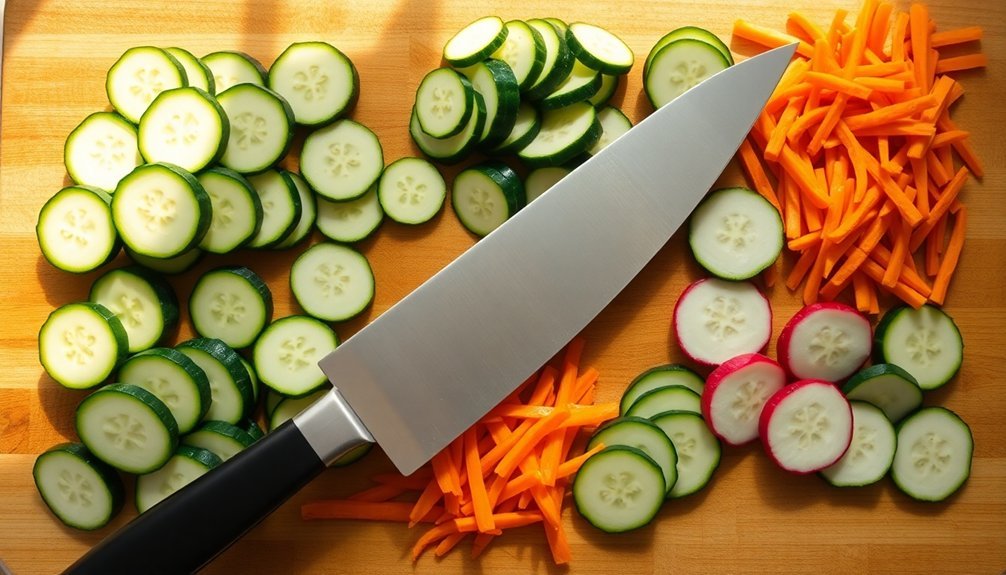
The way you cut vegetables directly impacts their moisture content and cooking performance. When you're preparing vegetables for sun-drying, uniform cuts guarantee even moisture distribution and consistent drying rates.
You'll want to slice diagonally to expose more surface area, which speeds up evaporation and enhances flavor absorption.
For ideal moisture control during preparation:
- Use a food processor or sharp knife to create identical-sized pieces that'll dry at the same rate.
- Cut vegetables on a diagonal angle to maximize the exposed surface area for faster drying.
- Pat vegetables dry after washing and arrange them in a single layer to prevent moisture trapping.
Remember to minimize water contact during prep and monitor your vegetables closely as they dry to achieve that perfect brittle texture with roughly 10% moisture content.
Quick Solar Cooking Cuts
When preparing vegetables for solar cooking, you'll want to create julienne strips or chunky diagonal cuts to maximize the surface area exposed to the sun's heat.
Your diagonal cuts should be made at a 45-degree angle to increase the exposed surface area while maintaining enough thickness for the vegetables to hold their shape.
These cutting techniques help your vegetables cook more efficiently in the solar oven by allowing heat to penetrate evenly across the larger exposed surfaces.
Solar-Ready Julienne Strips
Making julienne strips for solar cooking requires precision cuts that promote even heat distribution and quick cooking times.
You'll want to start with firm, fresh vegetables and a sharp chef's knife to achieve the perfect matchstick-sized pieces.
For ideal solar cooking results, follow these essential cutting steps:
- Wash and trim your vegetables into 2-3 inch segments, then create a flat base by removing a thin slice from one side.
- Slice the vegetable into thin planks (1/16 to 1/8 inch thick), stack them together, and cut into uniform strips.
- If you're working with cylindrical vegetables like carrots, try the bias-cut method by slicing at an extreme diagonal before creating your strips.
This uniformity guarantees your vegetables will cook evenly in your solar oven, maximizing efficiency and flavor.
Chunky Diagonal Surface Cuts
While julienne cuts offer precision, chunky diagonal surface cuts provide a faster alternative that's perfect for solar cooking. You'll want to start by positioning your knife at a 45-degree angle against your vegetable, then roll it 90 degrees after each cut to maintain consistent sizes.
| Vegetable | Best Cut Size | Solar Cook Time |
|---|---|---|
| Carrots | 1.5 inches | 15-20 min |
| Zucchini | 2 inches | 10-15 min |
| Eggplant | 2 inches | 20-25 min |
| Bell Peppers | 1.5 inches | 12-18 min |
| Cucumber | 1 inch | 8-12 min |
This technique works best with oblong vegetables and maximizes their exposure to heat. You'll notice faster cooking times in your solar oven since the increased surface area allows heat to penetrate more efficiently. Remember to keep your knife sharp for clean cuts and consistent results.
Temperature Zones and Sizes
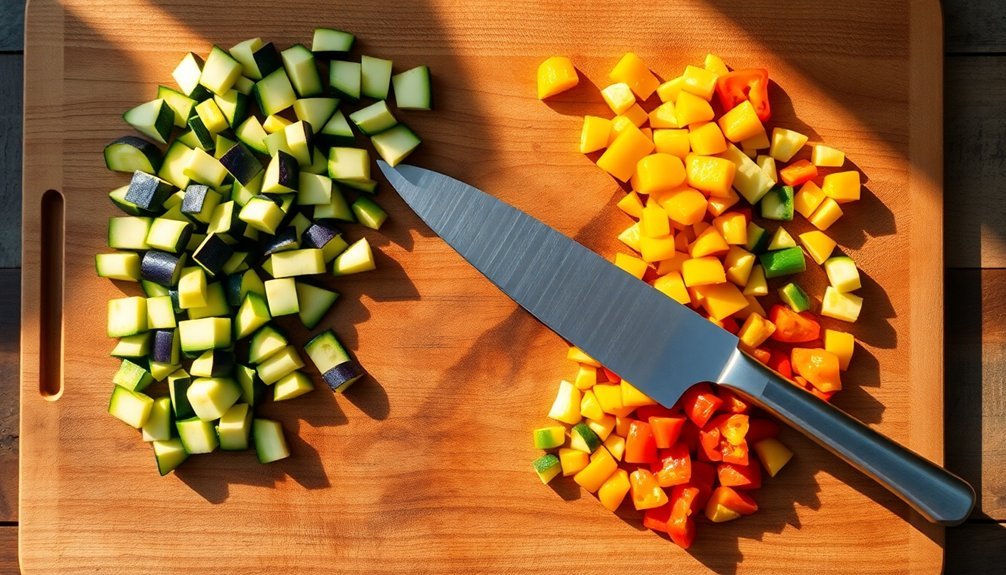
The perfect temperature and uniform cutting sizes are essential factors in roasting vegetables successfully.
You'll achieve the best results by roasting at 425°F, which creates that ideal crisp-tender texture with gorgeous caramelization. Remember to cut your vegetables uniformly, aiming for 1 to 1½-inch pieces to guarantee even cooking.
Here's what you'll notice when you nail the size and temperature combo:
- Softer vegetables like zucchini and broccoli will cook in 15-25 minutes, developing a golden-brown exterior.
- Root vegetables need 25-40 minutes to transform from hard to tender-crisp.
- Uniformly cut pieces will cook simultaneously, preventing the frustration of burnt edges and raw centers.
Keep your vegetables from overlapping on the baking sheet, and you'll get that perfect roast every time.
Layering Cut Vegetables
Now that you've mastered the right temperature and sizing, proper layering will elevate your vegetable dishes to new heights.
Start by preparing a flavorful base layer – rub your baking dish with garlic, then add olive oil and partially cooked onions for moisture and aromatics.
Select vegetables of similar circumference, like tomatoes, zucchini, and eggplant, cutting them to uniform sizes. If you're using smaller vegetables, combine two or three slices to match larger ones.
Arrange the slices vertically in tight rows to prevent shrinkage during cooking.
Between each layer, add salt, pepper, and fresh herbs. Don't forget to drizzle olive oil throughout to help tenderize the vegetables and create crispy edges.
Cover with foil if needed to prevent over-browning while ensuring everything cooks evenly.
Frequently Asked Questions
Can I Prepare Cut Vegetables the Night Before Solar Cooking?
You can prepare cut vegetables the night before, but you'll get better results if you store them properly. Keep potatoes in water, use airtight containers, and refrigerate everything to maintain freshness until cooking.
How Do Weather Conditions Affect the Size I Should Cut Vegetables?
You'll need to cut vegetables larger in cold weather and smaller in hot conditions. For humid days, make thinner slices to prevent moisture buildup, while dry, windy weather allows for bigger cuts.
Which Vegetables Should Never Be Mixed When Sun-Baking?
You shouldn't mix fast-cooking vegetables like tomatoes with slow-cooking ones like parsnips. Also, keep delicate red onions separate from hardy root vegetables to avoid uneven cooking and mushy results.
Does Vegetable Color Affect Cooking Time in Solar Ovens?
Yes, vegetable color considerably affects your solar cooking time. You'll find darker vegetables cook faster because they absorb heat more efficiently, while lighter-colored ones take longer due to lower heat absorption rates.
Should Vegetables Be Cut Differently at Different Altitudes for Solar Cooking?
You don't need to cut vegetables differently at different altitudes. While altitude affects cooking time and liquid needs, your cutting technique should focus on uniform sizes for even cooking regardless of elevation.
In Summary
You've now mastered the essential techniques for cutting vegetables that'll maximize their sun-baked potential. By following these size guidelines and moisture control methods, you're ready to create perfectly cooked dishes using solar energy. Remember to match your cuts to temperature zones, layer strategically, and keep your tools sharp. With these skills, you'll transform raw produce into delicious sun-cooked meals every time.





Leave a Reply